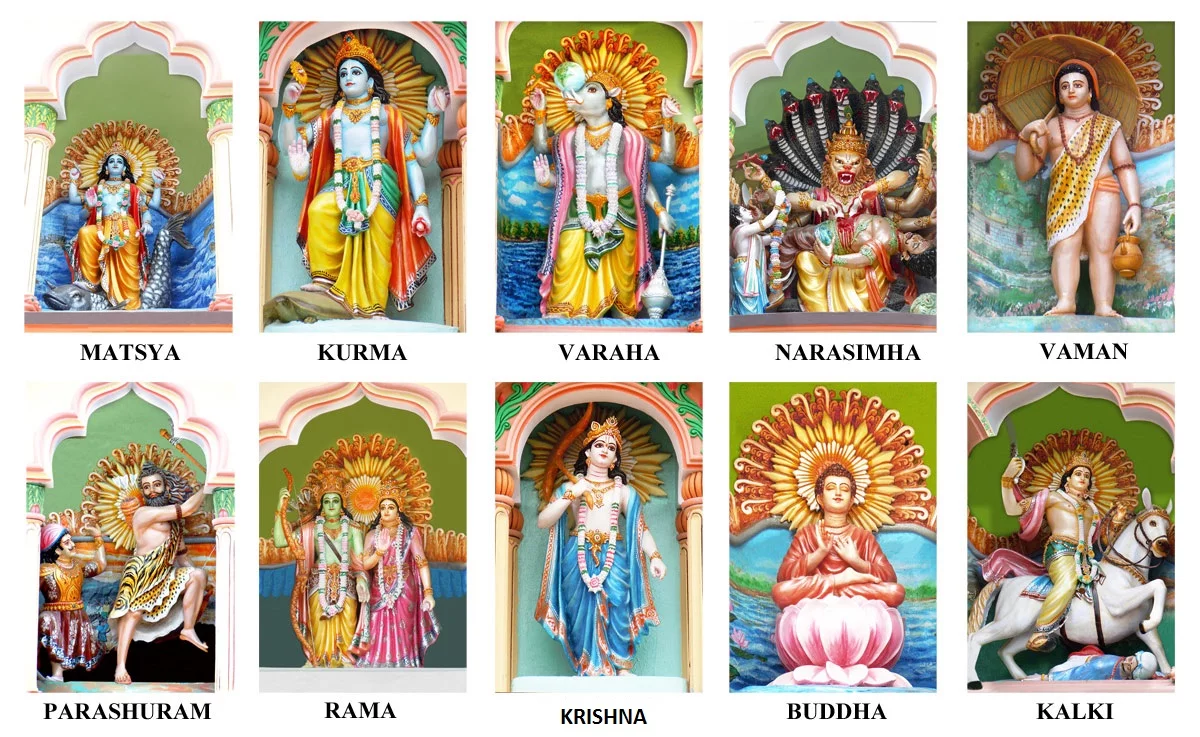
Vishnu, one of the principal deities in Hinduism, is believed to have taken on various avatars (incarnations) to restore balance and righteousness in the world. The most famous and widely recognized incarnations of Vishnu are the Dashavatara, which means “ten avatars.” These ten avatars represent different forms and roles that Vishnu assumed over time. Here is a list of the Dashavatara:
- Matsya (The Fish): In this avatar, Vishnu took the form of a fish to save the ancient scriptures and the sage Manu from a great deluge (flood).
- Kurma (The Tortoise): Vishnu incarnated as a tortoise to support Mount Mandara, which was used as a churning rod during the churning of the cosmic ocean (Samudra Manthan).
- Varaha (The Boar): In this form, Vishnu appeared as a boar to rescue the Earth (personified as the goddess Bhudevi) from the demon Hiranyaksha, who had submerged it in the cosmic ocean.
- Narasimha (The Man-Lion): Vishnu assumed the form of a half-man, half-lion to protect his devotee Prahlada and defeat the demon king Hiranyakashipu, who had received a boon making him invulnerable to man or beast, indoors or outdoors, at day or night.
- Vamana (The Dwarf): In this incarnation, Vishnu took the form of a dwarf Brahmin to subdue the demon king Bali, who had gained control over the three worlds. Vamana requested three paces of land and, with three steps, covered the entire cosmos.
- Parashurama: Vishnu incarnated as Parashurama, a warrior with an axe, to rid the world of corrupt and oppressive Kshatriya rulers. He is known as the “Warrior Brahmin.”
- Rama: Lord Rama is one of the most revered avatars of Vishnu. He is the central character of the epic Ramayana and is known for his unwavering devotion to dharma, his righteousness, and his role as a king.
- Krishna: Lord Krishna, perhaps the most famous of Vishnu’s avatars, is known for his teachings in the Bhagavad Gita and his role as a divine lover, protector, and the key figure in the Mahabharata. He is associated with love, compassion, and spiritual wisdom.
- Buddha: Some traditions consider the historical Buddha, Siddhartha Gautama, as an avatar of Vishnu. In this form, Vishnu’s purpose was to teach compassion and non-violence, guiding people away from excessive ritualism.
- Kalki: Kalki is believed to be a future avatar of Vishnu, who is expected to appear in a time of great turmoil and chaos. Kalki is prophesied to bring an end to the current age of darkness and corruption and establish a new era of righteousness.
These ten avatars of Vishnu illustrate his various roles and purposes in maintaining cosmic order, protecting the righteous, and defeating evil forces. The Dashavatara is an important concept in Hindu mythology and has significant religious and philosophical significance.
